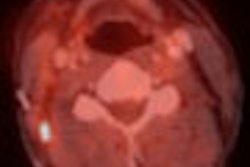ORLANDO, FL - A program designed to help researchers comply with the Centers for Medicare and Medicaid Services' (CMS) new PET reimbursement rules was unveiled Sunday at the Academy of Molecular Imaging (AMI) meeting.
Developed by AMI and the American College of Radiology Imaging Network (ACRIN), the PET registry will be used by CMS to "provide provisional coverage for PET for a variety of new indications, including cervical, brain, pancreatic, ovarian, and testicular cancers, with permanent coverage pending results of clinical trials and evaluation of the data registry," explained Dr. Bruce Hillner of the Virginia Commonwealth University Health System in Richmond, VA, and chair of the ACRIN registry project.
"This is a very innovative decision on the part of CMS," Hillner added.
PET centers will be required to apply for participation in the project. The proposed application fee is $50, as well as a $50 per-patient case-processing fee. As part of its application, the PET facility will need to provide:
- Data on its location and Medicare provider number
- An official point of contact for correspondence with the registry
- The participating radiologists who will be interpreting PET scans
- Equipment details on each PET scanner
According to Hillner, the PET registry workflow will begin with a clinician request for a PET study. The referring physician will be sent, via e-mail or paper, a pre-PET clinical report form (CRF). The data form requests patient demographics, the specific reasons for the PET scan, the cancer type and working stage, the patient performance status, intended management, and the cancer care provider.
There are five options on the form for the specific reasons for the PET scan:
- Diagnosis
- Initial staging of histologically confirmed, newly diagnosed cancer
- Monitoring treatment response
- Restaging
- Suspected recurrence
The diagnosis category has been further segmented into three elements: diagnosis to determine if a suspicious lesion is cancer; diagnosis of an unknown primary tumor to detect a primary tumor site in a patient with a confirmed metastatic lesion; and diagnosis/paraneoplastic to detect a primary tumor in a patient with a presumed paraneoplastic syndrome.
"The primary study endpoint, asked before and after the PET scan, is: If PET was not available, what would be your current management strategy?" Hillner said.
As part of the CRF, the PET registry will require that a short (approximately five questions) planned management form be filled out by the referring physician both before and after the PET scan. In addition, after the PET scan, a follow-up questionnaire of five to six questions per indication will be requested of the referring clinician, according to Hillner.
There will also be a question inquiring if the PET scan enabled the referring physician to avoid more tests or procedures, Hillner said.
The CRF will need to be filled out completely and in the registered PET center no later than midnight the day before the patient's scheduled exam for the study to be reimbursed as part of the national registry, Hillner explained. Once the exam has been completed and a report issued by the diagnostic clinician, the referring physician will be required to fill out a post-PET CRF, either by e-mail or online, before the PET center is notified that it can bill CMS for reimbursement.
The CRF and workflow process for the registry were created on the basis of input from clinicians and professional organizations such as the ACR, Society of Nuclear Medicine, American Society of Clinical Oncology, and the American College of Nuclear Physicians, Hillner noted.
ACRIN recently discovered a speed bump to the early implementation of the U.S. PET registry in the form of the Paperwork Reduction Act. According to Hillner, any new federally mandated form must be reviewed and approved by the Office of Management and Budget for its necessity for conducting government business. This process alone can take three or more months, he said.
Although no future extensions of the PET registry are currently funded, Hillner said that potential projects could examine actual versus intended management or outcomes analysis.
"The more radiologists and physicians participate in the program and the more data are submitted to the registry, the faster an indication could be approved for reimbursement," he said.
By Jonathan S. Batchelor
AuntMinnie.com staff writer
March 21, 2005
Related Reading
AMI, ACRIN partner on PET registry development, February 7, 2005
Medicare expands PET coverage for cervical cancer, January 31, 2005
AMI announces award winners, January 7, 2005
AMI, CancerSource launch consumer Web site, October 14, 2003
Copyright © 2005 AuntMinnie.com




















